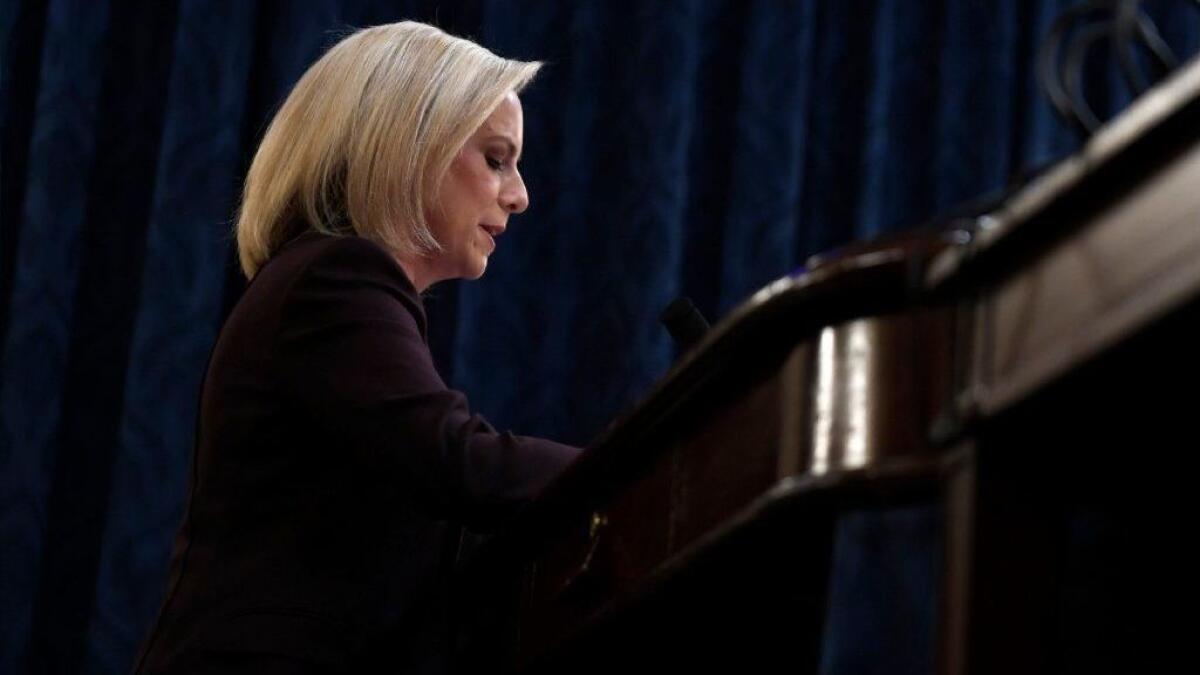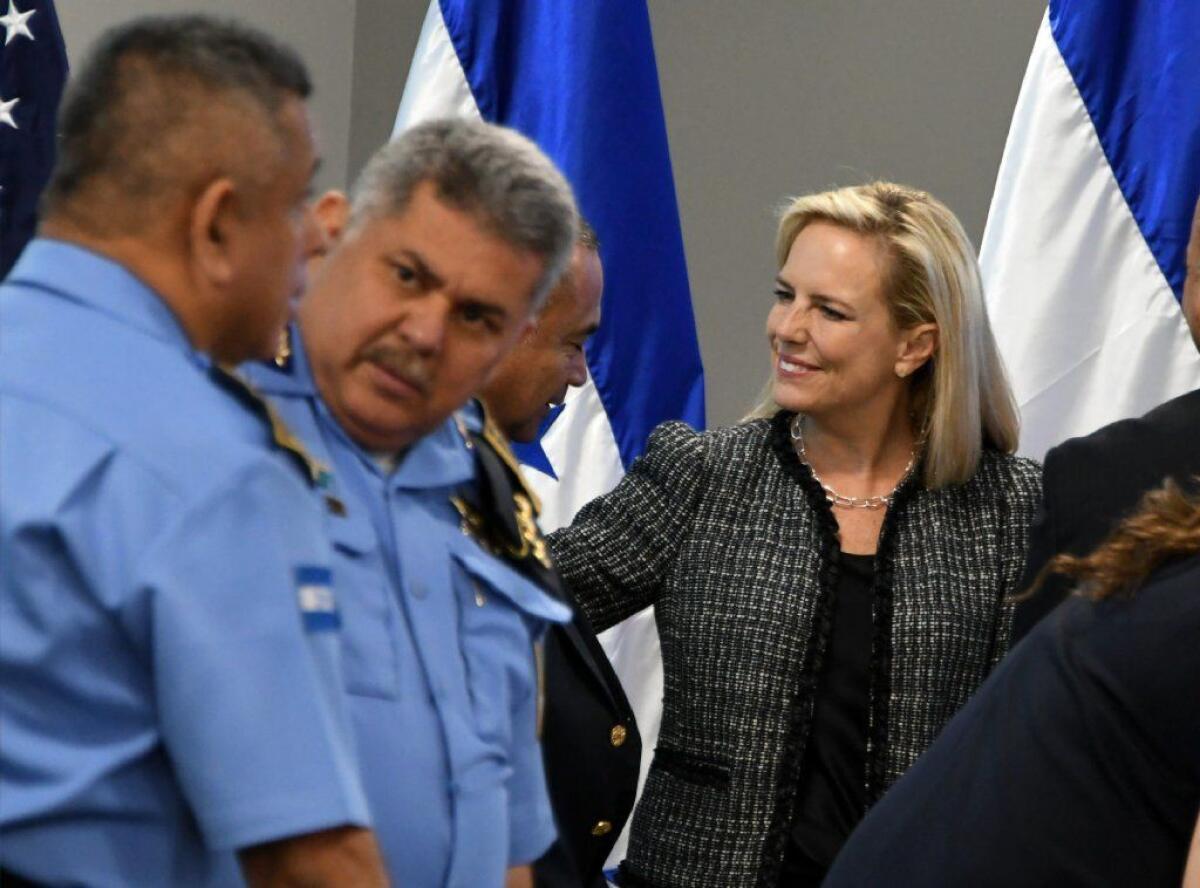Kirstjen Nielsen has hung on as Homeland Security secretary, but at what price?

- Share via
Reporting from Washington — Homeland Security Secretary Kirstjen Nielsen put down her pen, stood up and hugged the officials from El Salvador, Guatemala and Honduras, thanking them for their work on what she hailed as a “historic” pact to target unauthorized migration.
Within hours, President Trump had accused the “Northern Triangle” countries of doing “nothing” and threatened not only to cancel aid to all three, but to close the U.S.-Mexico border entirely.
“We’re not paying them anymore because they haven’t done a thing for us,” Trump declared.
For Nielsen, that incident last week was only the latest example of being publicly undercut by the president.
Fifteen months into her tenure as head of the government’s third-largest department, Nielsen embodies a paradox: She has succeeded in holding on to her job, defying numerous reports that Trump had decided to fire her, but has done so by becoming the public face of controversial policies that haven’t worked as planned — and in some cases have backfired.
Despite being publicly berated and rejected by Trump, the 46-year-old Nielsen, soon to be one of only four female Cabinet members, is one of its longest-serving members.
And one of its most embattled.
She faces House subpoenas and some two dozen investigations by the Homeland Security inspector general’s office over immigration and security policy. Record numbers of asylum seekers and Central American families have flooded the border.
And Trump has considered naming an “immigration czar” to coordinate the response, a move that Nielsen supports even though it would further dilute her authority.
In a Fox News op-ed Monday, Nielsen blamed “outdated laws, misguided court decisions, and a massive backlog of cases” for the increased migration and said she told Northern Triangle partners last week: “Time is up.”
“Real action is needed — now,” she wrote. “As a nation, we cannot stand for this.”
In an effort to try to stop Central Americans from claiming asylum in the U.S., the Trump administration has taken a series of controversial steps: separating children from their parents, sending roughly 6,000 troops to the southern border, detaining asylum seekers in tent cities and barbed-wire pens, and forcing asylum applicants to remain in Mexico while they await a U.S. court ruling that could be years away.
None of the deterrents has succeeded. Instead, the number of asylum applicants has soared. Customs and Border Protection estimates that apprehensions of border crossers will near 100,000 in March, topping February’s 66,450 arrests — more than almost any month in the last decade. The numbers will probably continue to rise as warmer weather brings a seasonal increase in migration.
“We face a system-wide meltdown,” Nielsen wrote to lawmakers on Thursday, requesting emergency powers such as the ability to more quickly deport unaccompanied Central American minors.
Outside critics and the department’s inspector general say the administration’s policies have worsened the crush at the border.
A move to limit access at ports of entry, for example, has given people an incentive to cross elsewhere. The administration’s refusal to seriously consider expanded cooperation with and aid to the Central American countries the migrants are fleeing all but guarantees the problem will worsen.
“Two years into his administration, Donald Trump has failed to scare these migrants away because they are fleeing desperate circumstances,” said Leon Rodriguez, director of U.S. Citizenship and Immigration Services from 2014 to 2017. “Unless they think about this in a different way, and don’t just keep dialing up on enforcement, nothing’s going to change.”
Trump’s latest threat, to close the border to all traffic, would risk serious damage to U.S. businesses. Administration officials want Mexico to work more aggressively to keep migrants from reaching the U.S. — a dicey bet given that country’s historical ambivalence about American migration policies and its limited resources dedicated to enforcement.
Nielsen serves two important roles for a president who sees political combat in the Twitter trenches as central to winning in 2020: He expects her to turn some of his highest-profile promises into policy, but also to take the heat when they’re met with controversy.
Her staunch defense of those policies — at the cost of her credibility with some members of Congress — pleases a president who prizes loyalty, even as it complicates her future, according to current and former officials who spoke with The Times.
The Homeland Security Department did not make Nielsen or another official available, nor provide comment.
“I think she’s being a good soldier,” said Rep. Bennie Thompson, a Mississippi Democrat and chairman of the House Homeland Security Committee. “She’s just trying to keep her job.”
A senior White House official conceded there were moments when Nielsen was on the outs, but said that especially with her defense of the president’s national emergency declaration in February, “her stature in the administration has only risen.”
“She’s still in the position of defending some of the less popular administration policies,” the official continued, requesting anonymity to speak about internal personnel matters. “I’d say that is going to consistently be her challenge; she’s going to be one of the administration officials who’s called to the Hill the most in this era of very heavy Democrat oversight.”
Immigration policy was once claimed as being a major victory for Trump. Early in his tenure, the number of people crossing the border without authorization dropped precipitously. As the numbers fell to a 45-year low, administration officials brushed aside suggestions of a temporary lull and proclaimed that Trump’s mere presence in office had changed everything.
But last weekend, two years later, U.S. officials detained hundreds of men, women and children underneath an international bridge in El Paso behind fencing and barbed wire.
As officials have long warned, the increase in Central American families seeking asylum has overwhelmed a U.S. immigration system designed decades ago for single Mexican men who could be promptly returned across the border.
The numbers remain below the highs from the 1980s into the mid-2000s, when U.S. agents routinely arrested more than 1 million people a year at the Mexico border. In fiscal 2017, officials arrested 303,916; in fiscal 2018, which ended Sept. 30, U.S. agents arrested 396,579 people, closer to the levels seen in the last years of the Obama administration.
But being well below the historical peak provides little comfort to Trump and his aides — including domestic policy advisor Stephen Miller and John Bolton, the president’s national security advisor — who talk of asylum seekers as “invaders.”
“I don’t get the sense that most people are satisfied with the status quo,” the senior White House official said.
Nielsen entered this difficult arena with much less experience than her predecessor as Homeland Security secretary, John F. Kelly — a retired Marine Corps four-star general who headed the military’s Southern Command before joining the administration.
As a young lawyer, three years after Sept. 11, 2001, Nielsen worked on President George W. Bush’s Homeland Security Council and managed legislative policy at the Transportation Security Administration. She then spent more than a decade in private-sector security consulting before volunteering to help serve as the “sherpa” guiding Kelly through his confirmation.
She followed him to Homeland Security as his chief of staff in early 2017, and to the White House when he became Trump’s chief of staff six months later.

In October 2017, Trump nominated Nielsen to replace Kelly as head of Homeland Security, whose more than 240,000 employees handle not only immigration and border security — Trump’s signature issues — but also cybersecurity, safeguarding elections and hurricane response.
She brought to the job a deep knowledge of policy, according to those who know her. “She’s literally an encyclopedia,” said Blain Rethmeier, who worked in the Bush White House with Nielsen and helped her and Kelly navigate their confirmations.
Still, Trump has viewed Nielsen with suspicion because of her association with the Republican establishment. And she has worked hard to show her dedication to a president who prizes loyalty.
Like Kelly, she has publicly backed, or declined to condemn, a number of Trump’s more extreme statements.
Shortly after takingthe helm at Homeland Security, Nielsen dodged questions from senators on whether Trump had described Haiti and some African countries as “shitholes” — stating a preference for immigrants from nations like Norway.
In July 2018, she echoed Trump’s claim that “both sides were to blame” after deadly violence between white supremacists and counter-protesters in Charlottesville, Va., the year before, saying: “It’s not that one side is right, one side is wrong.”
Through repeated controversies, she’s stuck with the administration line.
“She’s tenacious,” Rethmeier said. “A lot of people in this political environment would’ve tucked tail, resigned and gone to the private sector.”

Last year, with Trump incensed by reports of a large group of Central American migrants traveling north, he berated Nielsen for over half an hour in a Cabinet meeting.
In June, Nielsen stood at the White House podium and took ownership of the controversial tactic of splitting up migrant children and their relatives. Two days later, the president undercut her when, amid growing public outcry and bipartisan pressure, he signed an executive order to stop family separation.
Both Congress and the Homeland Security Department’s inspector general are investigating how the family separation policy came about — and whether Nielsen had been truthful in her testimony about it.
Then in October — standing before a border barrier bearing a plaque commemorating the president — Nielsen touted the first miles of Trump’s promised wall, though the newly erected replacement fencing in Calexico, Calif., was planned back in 2009.
Weeks later, just after deploying troops to the border ahead of the Nov. 6 midterm election, Trump canceled a trip with Nielsen to the Texas border, saying he’d decided to fire her.
In an interview with The Times just before he left the White House, Kelly, who declined to be interviewed for this story, said he’d warned colleagues not to take credit for drops in border crossings that would inevitably go back up.
As for Nielsen, he said, “She is her own woman; she is not a protege. … It’s a very, very difficult job.”
Twitter: @mollymotoole
More to Read
Get the L.A. Times Politics newsletter
Deeply reported insights into legislation, politics and policy from Sacramento, Washington and beyond. In your inbox three times per week.
You may occasionally receive promotional content from the Los Angeles Times.











